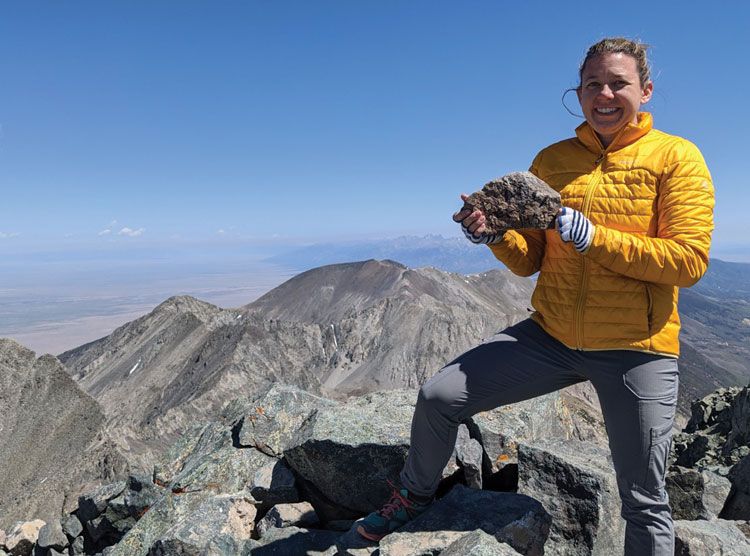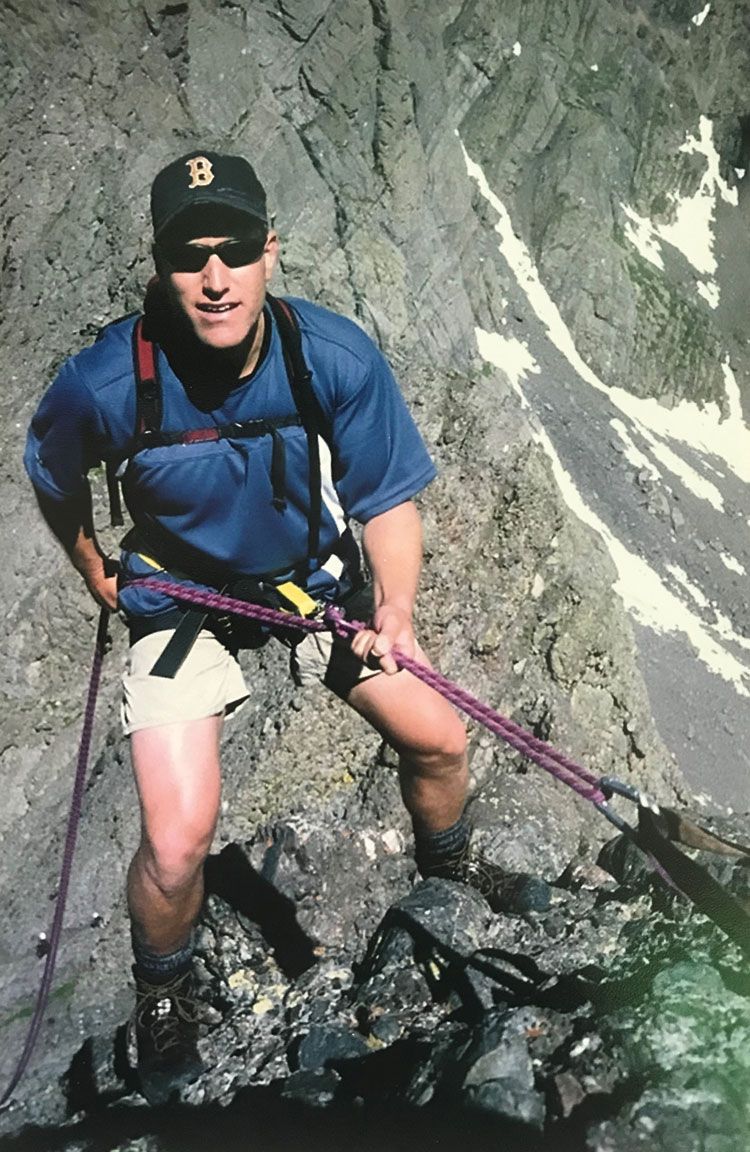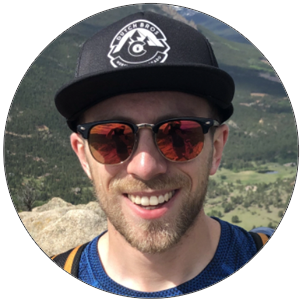For execs, climbing 14ers provides escape, imparts lessons

It was July 2001, about 14,050 feet above sea level on Sunlight Peak, and one block of exposed boulders was all that stood between John Tayer and completing his last Colorado 14er. Tayer started climbing 14ers when he moved to Colorado in the late 1980s for law school, and this one was all he needed to have climbed them all. Sunlight Peak — along with its neighbors Windom Peak and Mount Eolus — is perhaps the state’s most remote 14er, hidden in the wild Chicago Basin and accessible only by train or long backpacking trip.
Tayer, the president and CEO of the Boulder Chamber, had climbed Windom and Eolus earlier in the trip with a friend who’d accompanied him. For Sunlight, his friend wasn’t feeling well, so Tayer went up alone.
To reach the true summit of Sunlight Peak, climbers have to ascend an exposed pile of boulders with poor handholds and a sheer 1,000-foot drop if they slip. Dark clouds gathered as Tayer boulder-hopped to the top. When he got to the summit, he had another climber take his picture just as the clouds broke, then raced down the mountain through the rain and lightning.
SPONSORED CONTENT
How Platte River Power Authority is accelerating its energy transition
Platte River Power Authority, the community-owned wholesale electricity provider for Northern Colorado, has a history of bold initiatives.
“I just had this smile on my face because it was this feeling of having had this major accomplishment,” Tayer said.
Every year, more than 500,000 people climb Colorado’s 14ers. Tayer is one of many business executives in the state who make it a hobby — for fun, for an escape, even to learn lessons they can take back to the workplace.
“It’s really the all-encompassing experience that’s so rich for me,” Tayer said. “The beauty of the mountain, the challenge of the hike, the people you’re with, the surrounding communities.”
Chris Woods, founder of Terrapin Care Station, said he likes to solo hike 14ers because the solitude helps him clear his mind. Woods grew up in California and Pennsylvania and started hiking in the Sierra Nevadas and on trail sections as a kid. He got into Colorado 14ers when he came to get his Ph.D. in applied math at the University of Colorado.
“I’ve always climbed mountains, and it’s been in my blood,” Woods said. “I do a ton by myself. Being able to be around not that many people and not really think about anything else but climbing, it really clears my head. It helps empower my mind. It’s a nice balance with the stress of being an executive. It’s a healthy outlet.”
Woods said he enjoys climbing Longs Peak, often taking the less-used Loft route to avoid the major crowds that can flood the mountain. Terrapin also encourages its employees to pursue the hobby.
“We highlight how it’s an outlet and helps mental health,” Woods said. “We encourage employees to get outside and go hiking and climbing. It’s important for us as a company.”
Kristen Turnbull, community engagement lead for Kaiser Permanente, said that climbing is emotionally cathartic and even helps her think about work and leadership.
“Besides the obvious symbolism of climbing a mountain, I think the number of lessons that can be applied to life are just staggering,” Turnbull said.
For example, on a climb of the 14,345-foot Blanca Peak with her brother, they took turns leading and ensuring that they stayed caught up with each other.
“I was thinking about what it takes to lead your team and how useless it is if you leave people behind,” Turnbull said. “How do you train them properly? How do you give them what they need to get to the top of the mountain? What kind of tools do you give them to ensure they make it to the top with you?”
Turnbull’s first 14er wasn’t in Colorado; it was California’s Mount Whitney, at 14,505 the tallest mountain in the continental U.S. Its gruelling trail is more than 22 miles round trip and involves more than 6,100 feet of elevation gain across 99 switchbacks. During her first attempt to climb it with her then-husband, he began suffering from severe altitude sickness, and they had to turn around.
Over the intervening years, that marriage ended because of infidelity and Turnbull escaped from a second, abusive marriage. When she re-attempted Whitney with her brother in 2018, successfully climbing it felt like the culmination of everything she’d been through.
On that climb, Turnbull said, coming down Whitney emparted its own lessons. After the rush of endorphins when she hit the summit came the realization that she still had an 11-mile descent ahead of her with sore muscles and blistered feet. It took six hours, she said, or about a third of the entire climb. She said the descent helped her to process better what to do after accomplishing a major goal.
“How do you come down gracefully and not get frustrated?” Turnbull said. “Are you OK with the down the same way you are with the up?”
Turnbull said she and her brother are looking at Longs Peak as their next challenge. For Woods, he has eight 14ers on his itinerary this summer, he said. Tayer, having climbed them all, loves going back to those peaks and experiencing them again with friends who have never been up there.
“For me, when you think about executives, many are mission-driven and focused on accomplishing challenging tasks,” Tayer said. “For myself, that carried true, this notion of setting a goal for myself, a clear challenge, the joy, the thrill, the pride of mastering challenges. It is one of the most convenient ways to get an escape from the day-to-day and the opportunity to clear one’s head from all the normal work activity. When you’re on those 14ers, you get in the zone, and it’s a real escape.”

Boulder Chamber President and CEO John Tayer rappels off the summit of 14,203-foot Crestone Needle to begin the traverse to 14,295-foot Crestone Peak. Courtesy John Tayer
It was July 2001, about 14,050 feet above sea level on Sunlight Peak, and one block of exposed boulders was all that stood between John Tayer and completing his last Colorado 14er. Tayer started climbing 14ers when he moved to Colorado in the late 1980s for law school, and this one was all he needed to have climbed them all. Sunlight Peak — along with its neighbors Windom Peak and Mount Eolus — is perhaps the state’s most remote 14er, hidden in the wild Chicago Basin and accessible only by train or long backpacking trip.
Tayer, the president and CEO of…
THIS ARTICLE IS FOR SUBSCRIBERS ONLY
Continue reading for less than $3 per week!
Get a month of award-winning local business news, trends and insights
Access award-winning content today!


